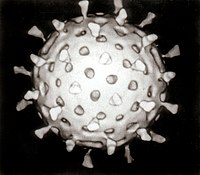
Photo from wikipedia
Abstract Extracellular vesicles releasing from various types of cells contribute to intercellular communication via delivering bio-molecules like nucleic acids, proteins, and lipids to recipient cells. Exosomes are 30–120 nm extracellular vesicles… Click to show full abstract
Abstract Extracellular vesicles releasing from various types of cells contribute to intercellular communication via delivering bio-molecules like nucleic acids, proteins, and lipids to recipient cells. Exosomes are 30–120 nm extracellular vesicles that participate in several pathological conditions. Virus-infected cells release exosomes that are implicated in infection through transferring viral components such as viral-derived miRNAs and proteins. As well, exosomes contain receptors for viruses that make recipient cells susceptible to virus entry. Since December 2019, SARS-CoV-2 (COVID-19) infection has become a worldwide urgent public health concern. There is currently no vaccine or specific antiviral treatment existing for COVID-19 virus infection. Hence, it is critical to find a safe and effective therapeutic tool to patients with severe COVID-19 virus infection. Extracellular vesicles may contribute to spread this virus as they transfer such receptors as CD9 and ACE2, which make recipient cells susceptible to virus docking. Upon entry, COVID-19 virus may be directed into the exosomal pathway, and its component is packaged into exosomes for secretion. Exosome-based strategies for the treatment of COVID-19 virus infection may include following items: inhibition of exosome biogenesis and uptake, exosome-therapy, exosome-based drug delivery system, and exosome-based vaccine. Mesenchymal stem cells can suppress nonproductive inflammation and improve/repair lung cells including endothelial and alveolar cells, which damaged by COVID-19 virus infection. Understanding molecular mechanisms behind extracellular vesicles related COVID-19 virus infection may provide us with an avenue to identify its entry, replication, spreading, and infection to overcome its adverse effects.
Journal Title: Infection, Genetics and Evolution
Year Published: 2020
Link to full text (if available)
Share on Social Media: Sign Up to like & get
recommendations!